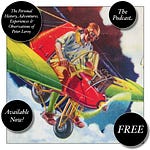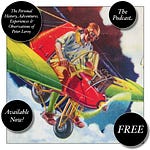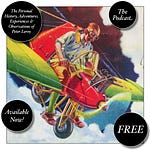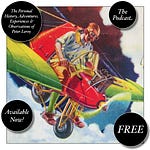[Episode seven of Dead Air, “Disturbing the Field”]
WHEN I WAS A BOY, there was quite a lot of interest in flying saucers. This was the popular name given to unidentified flying objects that were supposed to be the ships of voyagers from other worlds. Though they were called saucers, they resembled hubcaps. There was also quite a lot of interest in hubcaps at that time. (Since then, interest in flying saucers, inhabitants of other worlds, and hubcaps has declined. Today, it is limited to isolated groups of fanatics. Things change.)
I make no claim to having been immune to these popular enthusiasms, will deny neither the modest collection of hubcaps that I’d accumulated nor the flying-saucer detector that I built from plans in Cellar Scientist magazine.
The detector was a simple device: just a few pieces of wire, a compass needle, a battery, and a bulb. The plans included two diagrams: a “pictorial” and a “schematic.” Here is the pictorial, drawn from memory:
Here is the schematic, also drawn from memory:
You see the difference. The pictorial depicts the thing as we would see it if it were assembled by a professional using the highest-quality components, but the schematic is a depiction of the essence of the thing; instead of showing the thing, it shows the point of the thing, its function and meaning, the ding an sich. The pictorial is an attempt to represent the object, but the schematic is an attempt to represent the ideal underlying the object. All the electrical projects I built in my boyhood career as a builder of electrical projects included in their instructions both types of diagram: one for the realists and one for the idealists, the dreamers.
Was it the realists or the dreamers who were most expected to expect the detector to work? I’m not sure. I know that I never really expected it to work at all. I tried not to expect any of my projects to work; it kept the level of disappointment down.
In order to expect it to work, I would have had to assume that as a flying saucer passed overhead its engine (highly advanced, of course, and employing a source of power unknown on earth) would cause a local disturbance in the magnetic field, which would make a compass needle swing aside from its normal north-south orientation, and when the detector was finished, a remarkable phenomenon occurred: I bought that underlying assumption. I was proud of my work; because I was proud of my work I wanted to feel that it was work worth doing; because I wanted to feel that it was worth doing, I had to accept its conceptual underpinnings; so, I did.
When one accepts something like that, one does not want to be alone with one’s beliefs, feeling like a solitary deluded dreamer, so one seeks another who can be persuaded to accept the same beliefs. I turned to Porky White, who ran a clam bar in the older part of town, near the bay.
I climbed onto a stool at the counter and set the detector in front of me.
“Nice work,” said Porky. “What is it?”
“It’s a flying-saucer detector,” I said.
“How does it work?”
“Well, first I have to get it aligned.” I rotated the base until the needle was steady within the ring of wire. “There. Now, if a flying saucer passes by, it will disturb the magnetic field — ”
I paused. If Porky was going to object, if he was going to refuse to accept the underlying assumption, if he was going to say that my detector rested on a base of preposterous delusions, this was the point at which he would do it.
He folded his arms across his chest and nodded his head and said, “Because of the anti-gravity drive, I suppose.”
“Right,” I said, without, I think, betraying my relief. “The needle will swing and touch the wire, the current will flow, and the bulb will light.”
We both looked at the detector for a while. Nothing happened.
“How do you know it’s working?” he asked.
“Well, there are two tests,” I explained. I took a magnet from my pocket. “This is the positive test,” I said, and I passed the magnet over the detector. The needle swung, and the lamp lit.
“Wow,” said Porky.
I put the magnet away. The needle settled down and aligned itself north-to-south, resting in the center of the wire circle, with the lamp unlit.
I said, “This is the negative test.”
“Oh. I get it,” said Porky. He came around the end of the counter, walked across the room, stuck his head outside and scanned the sky. “Amazing!” he shouted. “Not a saucer in sight!”
[to be continued]
Have you missed an episode or two or several?
You can begin reading at the beginning or you can catch up by visiting the archive or consulting the index to the Topical Guide. The Substack serialization of Little Follies begins here; Herb ’n’ Lorna begins here; Reservations Recommended begins here; Where Do You Stop? begins here; What a Piece of Work I Am begins here; At Home with the Glynns begins here; Leaving Small’s Hotel begins here.
You can listen to the episodes on the Personal History podcast. Begin at the beginning or scroll through the episodes to find what you’ve missed. The Substack podcast reading of Little Follies begins here; Herb ’n’ Lorna begins here; Reservations Recommended begins here; Where Do You Stop? begins here; What a Piece of Work I Am begins here; At Home with the Glynns begins here; Leaving Small’s Hotel begins here.
You can listen to “My Mother Takes a Tumble” and “Do Clams Bite?” complete and uninterrupted as audiobooks through YouTube.
You can ensure that you never miss a future issue by getting a free subscription. (You can help support the work by choosing a paid subscription instead.)
At Apple Books you can download free eBooks of Little Follies, Herb ’n’ Lorna, Reservations Recommended, Where Do You Stop?, What a Piece of Work I Am, and At Home with the Glynns.
You’ll find overviews of the entire work in An Introduction to The Personal History, Adventures, Experiences & Observations of Peter Leroy (a pdf document), The Origin Story (here on substack), Between the Lines (a video, here on Substack), and at Encyclopedia.com.
















Share this post